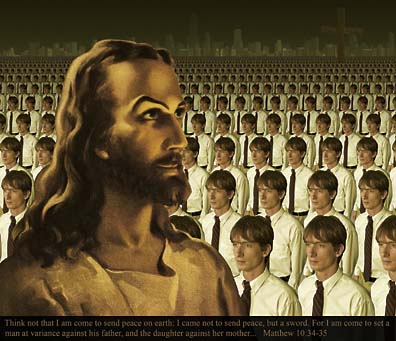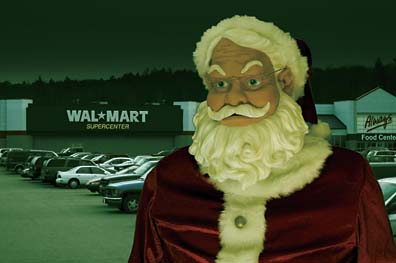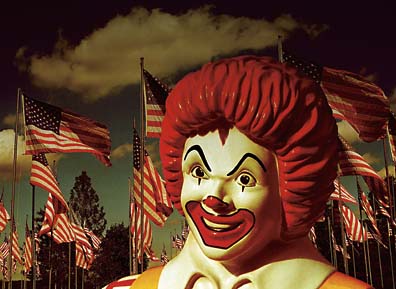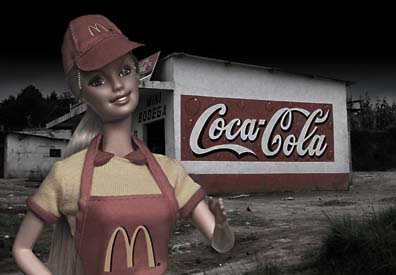 Jesus, Digital print, 6.8" x 8"
Jesus, Digital print, 6.8" x 8"Current Issue Highlights More Readings DA Home About Direct Art
Brad Busenius
Symbols of Power
by Brad Busenius
 Jesus, Digital print, 6.8" x 8"
Jesus, Digital print, 6.8" x 8"
In the Bible, Matthew 10:34-35, Jesus says, "Think not that I am come to send peace on earth: I came not to send peace, but a sword. For I am come to set a man at variance against his father, and the daughter against her mother…." This statement conveys the hidden meaning behind a symbol that influences religious fanatics. It represents the thoughts of a blue eyed, Aryan Jesus. When I look at the icon of Jesus I think about the mind control of fanatical organizations and the herd mentality of people who follow without thinking. It scares me that so many people will readily join the Watchtower Bible and Tract Society or follow people like Pat Robertson and Jerry Falwell.
My rendition of Jesus takes place in a pre-apocalyptic world where the commerce driven future connects with the primitive past. It is a world of cities, technology, business, and medical advances yet obsolete ideas about God still attract people. This image exposes the viewer to the man leading it all. Behind him, stretching off into the distance is an army of identical, expressionless clones. They are not dressed like their leader because they come from the contemporary world but their leader draws them despite his antiquated appearance. His followers all look forward, pointed in the same direction, yet with a menacing smile on his face—Jesus looks in a different direction. The direction in which Jesus looks is the future. He has plans for his followers, but can his plans be trusted? Are his plans what we are told, or are they something else? Are they the plans of God, or the plans of a man?
 Santa
Claus, Digital print, 5.319" x 8"
Santa
Claus, Digital print, 5.319" x 8"
The image of Santa Claus often goes unquestioned yet to me it is offensive. It’s not that I am against the spirit of giving, sharing, and helping others. At my foundation, I am a humanist and I love giving to others, however, is this what Santa Claus really symbolizes? If he was a real person, would he own a toy factory full of jolly elves or would he own a sweatshop full of underpaid Central American slaves? Would Santa have his workers magically make toys in the North Pole or would he order them from a multinational corporation? How would he feel when he was rushing around doing his last minute shopping on Christmas Eve? To me this image captures the true reality behind Christmas. It illustrates the real meaning behind the symbol of Santa Claus and the holiday. Christmas is not a time for giving. It is a time for multinational corporations to make exorbitant profits off the suffering of those less fortunate while making everyone miserable in the process. It is a time of guilt and high suicide rates.
In my version of Christmas the observer gets a glimpse of a more realistic Santa Claus. As Santa does his last minute shopping at the Walmart supercenter we catch a glimpse of an angry unappreciative Santa. He does not feel the joy of giving but rather the burden of Christmas. He is negative, stressed, and pessimistic as he buys poorly made consumer goods for expecting children. Under the green light of the dark sky we see a Santa that is more cynical than the one in storybooks. He is a more human Santa Claus. He resembles us.

Ronald McDonald is a corporate Christ and the most widely recognized symbol of globalization. His marketers would have you believe he is a jolly, fun-loving clown who likes kids. To me he represents the global domination of the many by the few. He represents poor health, corporate greed and gluttony. The restaurants for which he stands intrude upon cultures, force harmful values on people, produce tons of garbage and scar the earth with their ugly monoculture. In my portrayal of Ronald McDonald, American Flags stretch off into the distance in neat organized rows like tombstones representing death. A green polluted haze saturates everything. It is the contamination of a time and place where people put profit in front of morality, where apathetic consumers destroy the environment.
 McDonalds Barbie, Digital Print, 5.5" x 8"
McDonalds Barbie, Digital Print, 5.5" x 8"
The symbol of Barbie is a wretched concept. Many girls grow up playing with Barbie dolls. Some girls adopt her overtones while others live grudgingly under the tyranny of her symbolism. Barbie is often thought of as the typical all American girl. She is the blonde, large breasted, materialistic, dumb girl who’s image is embraced by American pop stars. Many people consider her the perfect catch or the ideal that women should strive to become. To me she is hideous. She stands for everything I would never want in a woman. Worse than that, however, is the idea behind McDonalds Barbie (an actual product). I was shocked when I first came upon her while strolling through a department store. I couldn’t believe this monstrosity was a toy that people would buy for their children. I couldn’t believe it was a toy that we, as a community, wanted to sell to our children. What kind of a message are we giving to young girls who play with these toys? My depiction of Barbie does not hide intentions with a fake smile and expressionless eyes. In this picture we catch a glimpse of Barbie when she thinks nobody is looking. Her true meaning is suddenly clear.
Big Boy is an icon for the family restaurant. As anyone who has worked in such a place knows, the family restaurant is hostile to creativity, individuality, and imagination. It is a place where people work hard for little pay, where quantity is valued over quality, productivity is valued over humanity and profit is valued over all else. In the restaurant efficiency replaces respect and ugliness subjugates beauty. In this image Big Boy displays a nefarious smile as he sneers at the viewer. He is standing in front of an industrial factory that is symbolic of the family restaurant. Just as factories pollute the earth with toxins, the chain restaurant pollutes the earth with garbage, waste and monoculture.
Brad Busenius grew up in Rochester Minnesota where he
became interested in art as a form of communication. He later attended Northern Michigan
University in Marquette Michigan where he received a BFA degree in Photography and
Electronic Imaging. Currently he resides near Burlington Vermont where he works fulltime
as a web developer. He does freelance web/graphic design and makes frequent trips to
Guatemala where he stays with the Mayan people. His greatest aspiration is to sell
photographs of the Mayan people to help them earn a better living wage.
busenius@gmail.com
www.digitalartbb.com
Current Issue Highlights More Readings DA Home About Direct Art